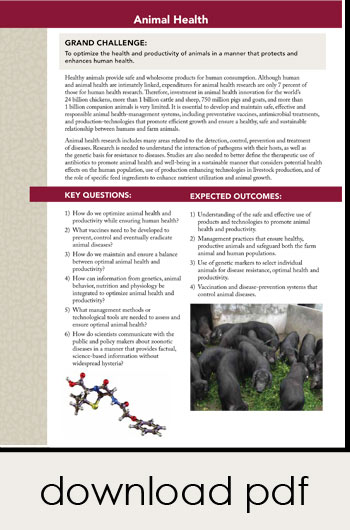Animal Health
Grand Challenge: To optimize the health and productivity of animals in a manner that protects and enhances human health.
 Healthy animals provide safe and wholesome products for human consumption. Although human and animal health are intimately linked, expenditures for animal health research are only 7 percent of those for human health research. Therefore, investment in animal health innovation for the world’s 24 billion chickens, more than 1 billion cattle and sheep, 750 million pigs and goats, and more than 1 billion companion animals is very limited. It is essential to develop and maintain safe, effective and responsible animal health-management systems, including preventative vaccines, antimicrobial treatments, and production-technologies that promote efficient growth and ensure a healthy, safe and sustainable relationship between humans and farm animals.
Healthy animals provide safe and wholesome products for human consumption. Although human and animal health are intimately linked, expenditures for animal health research are only 7 percent of those for human health research. Therefore, investment in animal health innovation for the world’s 24 billion chickens, more than 1 billion cattle and sheep, 750 million pigs and goats, and more than 1 billion companion animals is very limited. It is essential to develop and maintain safe, effective and responsible animal health-management systems, including preventative vaccines, antimicrobial treatments, and production-technologies that promote efficient growth and ensure a healthy, safe and sustainable relationship between humans and farm animals.
Animal health research includes many areas related to the detection, control, prevention and treatment of diseases. Research is needed to understand the interaction of pathogens with their hosts, as well as the genetic basis for resistance to diseases. Studies are also needed to better define the therapeutic use of antibiotics to promote animal health and well-being in a sustainable manner that considers potential health effects on the human population, use of production enhancing technologies in livestock production, and of the role of specific feed ingredients to enhance nutrient utilization and animal growth.
Key Questions:
- How do we optimize animal health and productivity while ensuring human health?
- What vaccines need to be developed to prevent, control and eventually eradicate animal diseases
- How do we maintain and ensure a balance between optimal animal health and productivity?
- How can information from genetics, animal behavior, nutrition and physiology be integrated to optimize animal health and productivity?
- What management methods or technological tools are needed to assess and ensure optimal animal health?
- How do scientists communicate with the public and policy makers about zoonotic diseases in a manner that provides factual, science-based information without widespread hysteria?
Expected Outcomes:
- Understanding of the safe and effective use of products and technologies to promote animal health and productivity.
- Management practices that ensure healthy, productive animals and safeguard both the farm animal and human populations.
- Use of genetic markers to select individual animals for disease resistance, optimal health and productivity.
- Vaccination and disease-prevention systems that control animal diseases.
Download the Grand Challenges Documents
Read each section:
Animal Health
Agricultural Animals and Climate Change
Food Safety
Global Food Security
Animal Well-Being
Training the Future Workforce




